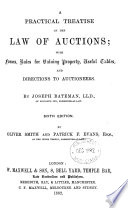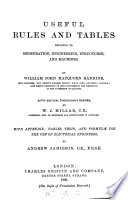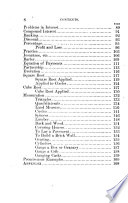 | William Paterson (Lieut.-Col.) - Military topography - 1882 - 206 pages
...perpendicular, and half the product will be the area. ~. = Triangla To find the area of a trapezoid : — Multiply half the sum of the two parallel sides by the perpendicular distance between them for the area. — - — a = Trapezoid. To find the area of a trapezium : — Multiply the diagonal... | |
 | Joseph Bateman - Auctions - 1882 - 576 pages
...convenient number of feet and inches. For a Trapezoid (two of the sides parallel, but not equal).—Multiply half the sum of the two parallel sides by the perpendicular distance between them. For a Trape.zinm (four straight sides of different lengths).—Obtain a diagonal, by measuring from... | |
 | William Dodds - 1883 - 198 pages
...area of a trapezoid when the parallel sides and the perpendicular distance between them are given. RULE. Multiply half the sum of the two parallel sides by the perpendicular distance between them, and the product will be the area. If two straight "iT lines are of unequal ! / length, the average... | |
 | William John Macquorn Rankine - 1883 - 454 pages
...by a pair of' parallel straight lines, and a pair of straight lines not parallel). Multiply the half sum of the two parallel sides by the perpendicular distance between them. 3. Triangle. RULE A. — Multiply the length of any one of the sides by one-half of its perpendicular... | |
 | William Waterston - 1884 - 314 pages
...the square of 3 being 9, we have 9 X 3.1416 - 28-2744 square miles. 10. Area of a trapezoid: Multiply the sum of the two parallel sides by the perpendicular distance between them, and take half the product. Ex. The parallel sides are 4.32 feet and 5.48 feet, and the perpendicular... | |
 | Education - 1885 - 630 pages
...Mensuration. Answer one Question. I. State and prove the rule for finding the area of a trapezoid. Multiply half the sum of the two parallel sides by the perpendicular distance between them, and the product will give the area. sides. The area of ABCDs=$ AB and CD x perpendicular distance BG... | |
 | M. P. Caldwell - Arithmetic - 1883 - 198 pages
...garden whose area is J an acre; it is 110 yards long; how wide is it? Ans. 22 yds. PROPOSITION 5.— To find the area of a trapezoid. RULE. — Multiply half the sum of the parallel sides by the altitude, and the product is the area. Or, place the altitude and half the sum... | |
 | Frank Eugene Kidder - Architecture - 1886 - 640 pages
...(ce + i 2 FJ. '9-27 = area (Fig. 27). To Jind the area of a trrtpezoicl (Fig. 28). HULK. — Multiply the sum of the two parallel sides by the perpendicular distance between them, anil divide the product by 2. To compute the area of an irregular polygon. RULE. — Divide the polygon... | |
 | John H. Macke - Carpet laying - 1891 - 244 pages
...than a right angle? If less or greater than a right angle, what is the proper definition of the angle? To find the area of a trapezoid. RULE. Multiply HALF THE SUM of the two parallel sides by the altitude of the trapezoid; that is, by the distance between the two parallel sides. Example. Find the... | |
 | Frank Eugene Kidder - Architecture - 1892 - 1032 pages
...X (ce + di) F'3.27 = area (Fig. 27). To find, the area of a trapczoid (Fig. 28). RULE. — Multiply the sum of the two parallel sides by the perpendicular distance between them, and divide the product by 2. To compute the area of an irregular polygon. RULE. — Divide the polygon... | |
| |